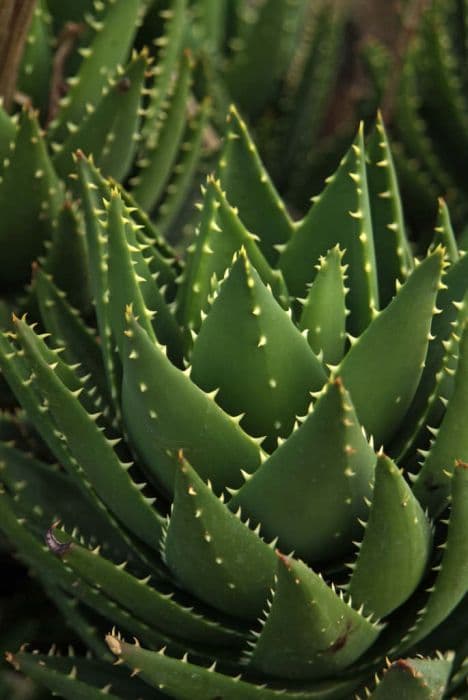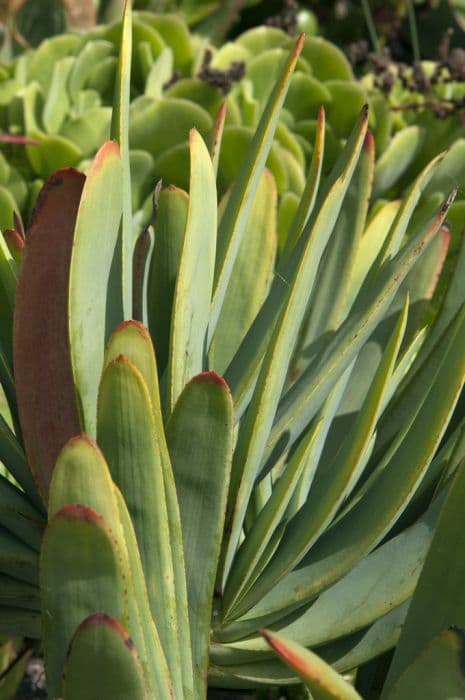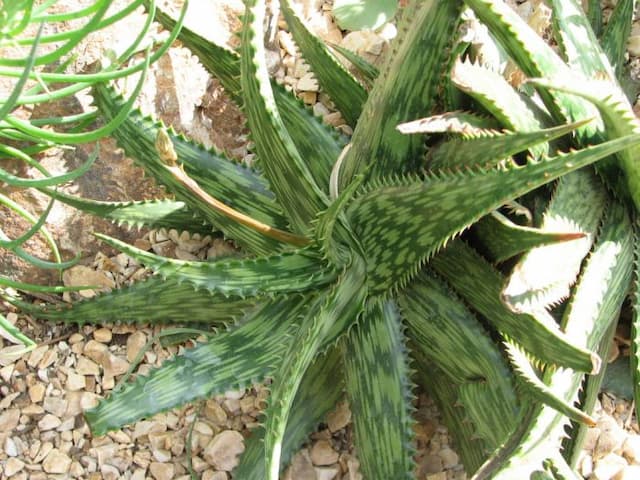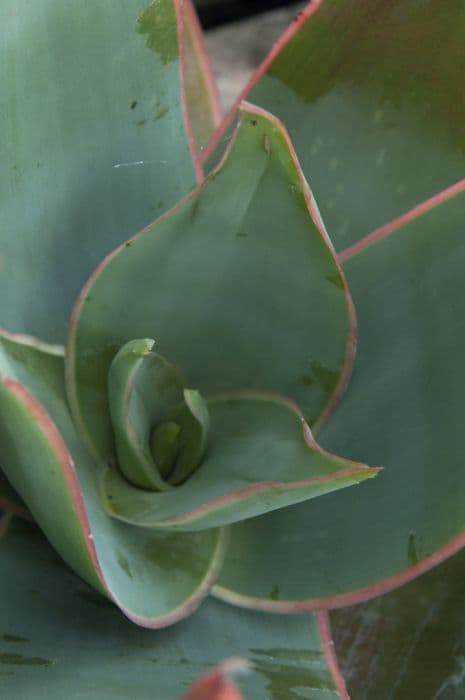Kniphofia 'Alcazar'

ABOUT
The Kniphofia 'Alcazar', commonly known as Red Hot Poker, boasts a distinctive and striking appearance. This plant is characterized by its bold, torch-like flower spikes that emerge above the foliage, creating an eye-catching display. The blossoms, which progress from top to bottom, present a blend of warm colors, typically ranging from fiery red at the tip, blending into orange and sometimes fading to yellow or greenish at the base, resembling a flickering flame. The foliage of the Red Hot Poker forms a dense clump, with grass-like leaves that are long, slender, and arched. These leaves are usually a rich green color and provide a lush backdrop for the dramatic flower spikes. The overall impression is one of vibrant color and vertical interest, which draws attention and adds an exotic touch to any garden setting. The plant blooms during the summer months, and its unique flowers are known to attract hummingbirds and other pollinators.
About this plant
 Names
NamesFamily
Asphodelaceae
Synonyms
Red Hot Poker, Torch Lily, Tritoma
Common names
Kniphofia 'Alcazar'.
 Toxicity
ToxicityTo humans
Red hot poker is generally considered non-toxic to humans. However, as with many plants, individual parts may cause irritation or an allergic reaction in some people. If parts of the plant are ingested, they could potentially cause stomach upset or discomfort. Always handle plants with care and avoid ingesting any parts of ornamental plants.
To pets
Red hot poker is not commonly listed as a toxic plant to pets such as dogs and cats. However, it is always a cautious practice to prevent pets from ingesting plants not intended for consumption as they might cause gastrointestinal upset or an allergic reaction in sensitive individuals. If you suspect your pet has ingested any part of the plant and is showing symptoms, consult your veterinarian.
 Characteristics
CharacteristicsLife cycle
Perennials
Foliage type
Evergreen
Color of leaves
Green
Flower color
Mixed
Height
3-4 feet (0.9-1.2 meters)
Spread
2 feet (0.6 meters)
Plant type
Herbaceous
Hardiness zones
5
Native area
Africa
Benefits
 General Benefits
General Benefits- Attracts pollinators: Kniphofia 'Alcazar', commonly known as Red Hot Poker, is known to attract bees, butterflies, and hummingbirds, which are beneficial for pollination.
- Drought tolerance: Once established, this plant is quite tolerant to drought, reducing the need for frequent watering.
- Visual interest: The striking red to orange flower spikes add a distinctive, bold color to landscapes and gardens.
- Low maintenance: Red Hot Pokers are generally easy to care for and don’t require much maintenance, making them a good choice for gardeners of all skill levels.
- Deer resistance: The plant is not a preferred choice for deer, which can help prevent damage in areas where deer browsing is a concern.
- Long blooming season: With a blooming period that stretches from early to late summer, this plant can provide long-lasting color and interest in a garden setting.
- Versatility in garden design: Kniphofia 'Alcazar' can be used in a variety of garden styles, including borders, containers, and as a focal point.
- Hardiness: This plant is hardy in many climates, making it suitable for growing in a range of different zones.
 Medical Properties
Medical PropertiesThis plant is not used for medical purposes.
 Air-purifying Qualities
Air-purifying QualitiesThis plant is not specifically known for air purifying qualities.
 Other Uses
Other Uses- As a natural dye: The flowers of the Red Hot Poker can be used to produce yellow and green dyes for coloring fabrics or materials.
- In eco-printing: The unique shape and texture of Red Hot Poker leaves can create interesting patterns when used in the eco-printing process on paper or textiles.
- As a source of nectar in beekeeping: Red Hot Poker can be cultivated to provide an excellent source of nectar for bees, thus supporting honey production.
- Companion planting: These plants can be strategically placed in the garden to help deter pests from more vulnerable crops or enhance the growth of others.
- Photography subject: With its striking flowers, the Red Hot Poker is a favorite among photographers and artists looking for interesting floral subjects.
- Theme gardens: Red Hot Poker can be used in fire-themed gardens due to its fiery-colored blooms.
- Floral arrangements: The tall and vivid blooms make for an exotic addition to cut floral arrangements and bouquets.
- Educational use: Its unique morphology and pollination strategy can serve as an educational tool in botany and horticulture classes.
- Soil erosion control: The plant's extensive root system can help stabilize soil on slopes and banks, reducing erosion.
- Garden sculpture: When dried, the striking flower spikes of Red Hot Poker can be used to add structure and interest to garden beds in the winter months.
Interesting Facts
 Feng Shui
Feng ShuiThe Red Hot Poker is not used in Feng Shui practice.
 Zodiac Sign Compitability
Zodiac Sign CompitabilityThe Red Hot Poker is not used in astrology practice.
 Plant Symbolism
Plant Symbolism- Attraction: Kniphofia, commonly known as Red Hot Poker, due to its bright, fiery flowers, symbolizes attraction and fascination.
- Strength: The robust, tall spikes of the Red Hot Poker represent strength and steadfastness.
- Wealth and Prosperity: The lush and vibrant appearance of the plant is often associated with wealth and prosperity.
- Standout Presence: With its unique and eye-catching blooms, Red Hot Poker signifies having a standout presence or being noticed.
 Water
WaterThe Red Hot Poker plant requires consistent moisture, especially during the growing season. Water the plant deeply once a week, providing about one inch of water each time. Ensure the soil is well-drained to prevent root rot. During hot or dry spells, increase watering frequency to maintain slightly moist soil. In winter, reduce watering to accommodate the plant's dormancy period, allowing the soil to dry out slightly between waterings.
 Light
LightThe Red Hot Poker thrives in full sun conditions where it can receive at least six to eight hours of direct sunlight daily. Choosing a location that provides unfiltered daylight will promote the best growth and flowering. While it can tolerate some light shade, too much shade can result in weak growth and fewer blooms.
 Temperature
TemperatureRed Hot Poker plants are adaptable to a variety of temperature conditions and can survive temperatures as low as 0°F, making them suitable for USDA hardiness zones 5 through 9. However, they grow best in temperatures ranging between 50°F and 75°F. Excessive heat can be mitigated with increased watering, but generally, these plants are quite heat tolerant once established.
 Pruning
PruningPruning Red Hot Poker plants is primarily done to remove spent flower stalks and to tidy up the plant's appearance. It's best to prune the flower spikes once they have faded to encourage more blooms. Additionally, in late fall or early spring, cut back any damaged or dead foliage to maintain plant health. This helps stimulate new growth and keeps the plant looking its best.
 Cleaning
CleaningAs needed
 Soil
SoilThe Red Hot Poker (Kniphofia 'Alcazar') flourishes in a soil mix that has good drainage, loamy texture, and a pH ranging from 6.0 to 6.5. A combination of two parts garden soil, one part sand, and one part compost or well-rotted manure will ensure nutrients and proper drainage.
 Repotting
RepottingRed Hot Poker plants typically do not need frequent repotting. They should be repotted every 3 to 5 years, or when the clump becomes too large for its current space, to maintain vigor and blooming.
 Humidity & Misting
Humidity & MistingThe Red Hot Poker plant is tolerant of various humidity levels but thrives best in average ambient humidity. As long as the soil drainage is good, the plant can adapt to the local outdoor humidity conditions.
 Suitable locations
Suitable locationsIndoor
Provide full light and well-draining soil for indoor Red Hot Poker.
Outdoor
Plant in full sun and well-draining soil; protect from harsh winds.
Hardiness zone
5-9 USDA
 Life cycle
Life cycleKniphofia 'Alcazar', commonly known as Red Hot Poker, starts its life as a seed which, when sown in well-drained soil and warm conditions, germinates to produce a small rosette of narrow, arching leaves. As it enters the vegetative stage, the plant develops a strong root system and lush foliage, thriving in full sun to part shade. The transition to the flowering stage occurs in late spring to early summer, marked by the emergence of tall, striking flower spikes that boast tubular flowers progressing from rich red hues at the top to a warmer yellow at the base. After pollination, often assisted by birds and bees, the flowers will eventually wilt and set seed. The plant then enters a period of dormancy in the colder months, where growth slows and some foliage may die back. Come spring, Kniphofia 'Alcazar' emerges from dormancy, ready to begin the cycle again with renewed growth and subsequent flowering.
 Propogation
PropogationPropogation time
Spring-Early Summer
Kniphofia 'Alcazar', commonly known as Red Hot Poker, is generally propagated through division, which is a popular method for perennial plants like this. The best time to divide Red Hot Poker plants is in the spring or early fall when the plant is not in active growth. To propagate by division, begin by gently digging around the clump of the plant with a shovel, taking care not to damage the root system too much. Once lifted from the ground, use your hands or a sharp knife to divide the clump into smaller sections, ensuring that each new section has a portion of the roots and at least one growing point or shoot. Replant the divisions at the same depth they were originally growing, spacing them about 18 inches (approximately 45 centimeters) apart to allow for growth and ensuring that they are watered well to establish. This method of propagation is effective and helps to rejuvenate older clumps that might otherwise become woody and less prolific in blooming.









